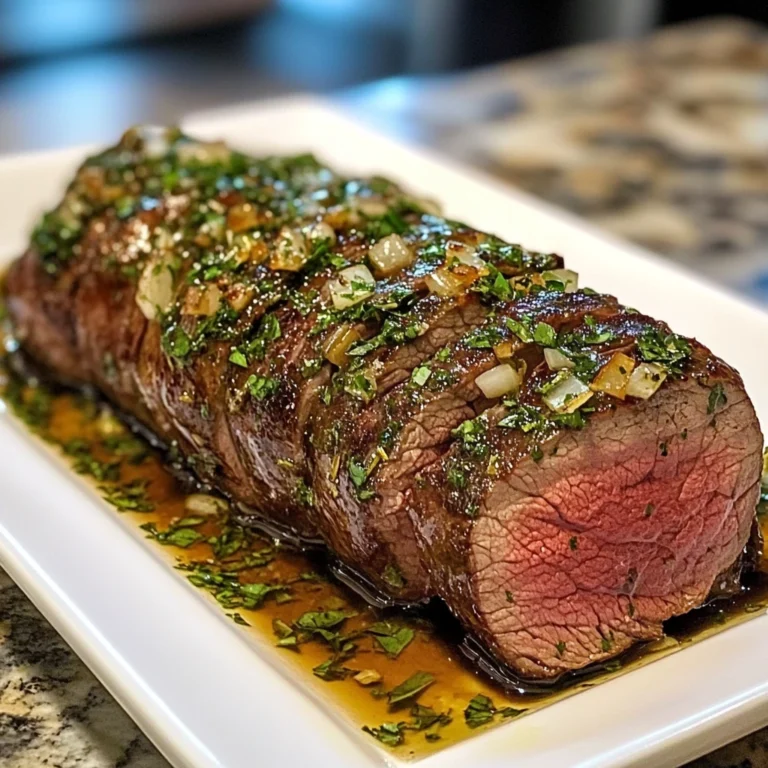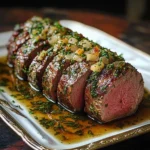Introduction
When it comes to special occasions and holidays, few dishes can rival the elegance and flavor of a Herb Butter Beef Tenderloin Roast. This dish is a favorite for gatherings thanks to its incredible tenderness and the infusion of flavors from a perfectly seasoned herb butter. Whether you’re celebrating Christmas, Thanksgiving, or a milestone anniversary, this recipe delivers a show-stopping main course that’s both satisfying and visually stunning.
The combination of the succulent beef tenderloin and a rich, aromatic herb butter creates a harmonious balance of flavors that tantalizes the taste buds. From the crispy seared crust to the juicy, medium-rare center, every bite is a celebration of culinary perfection. If you’re new to cooking beef tenderloin, worry not—this guide will walk you through each step to ensure your roast turns out flawless. For a deeper dive into beef tenderloin and its cuts, check out this helpful guide to learn how it compares to other cuts like prime rib.
Understanding Beef Tenderloin
Beef tenderloin is a prized cut of meat known for its buttery texture and unmatched tenderness. This long, narrow muscle runs along the cow’s spine and sees minimal use, which is why it’s so incredibly tender. The tenderloin is often cut into portions, including the beloved filet mignon, but cooking the whole roast elevates it to a centerpiece-worthy meal.
Characteristics of Beef Tenderloin
- Flavor: Mild yet rich, making it an excellent base for bold seasonings like herb butter.
- Texture: Velvety smooth, which melts in the mouth when properly cooked.
- Size: Typically weighing 3–4 pounds, perfect for feeding 6–8 guests.
Differences Between Beef Tenderloin and Prime Rib
While both cuts are popular for holiday roasts, they differ significantly:
- Tenderloin: Leaner with minimal marbling, prized for its texture.
- Prime Rib: Richer in flavor due to higher fat content and marbling. For more insights on beef cuts, explore this detailed comparison.
Choosing the Best Beef Tenderloin
Selecting a high-quality cut is crucial for achieving the best results:
- Go for USDA Prime or Choice: These grades offer the best balance of tenderness and flavor.
- Consider Center-Cut: Evenly shaped for uniform cooking.
- Avoid Frozen Cuts: Fresh tenderloin ensures optimal texture and flavor.
Investing in a high-quality tenderloin ensures that your roast is not just a meal but an experience. By following this guide, you’ll craft a dish that’s as delightful to eat as it is to prepare.
Selecting the Right Ingredients
Creating a Herb Butter Beef Tenderloin Roast begins with choosing the finest ingredients. Each component plays a vital role in delivering the dish’s signature flavors and textures. Here’s a breakdown of the key ingredients and why they’re essential.
Beef Tenderloin
- Why it matters: The tenderloin is the star of the dish, offering unparalleled tenderness and a subtle, rich flavor.
- Tips for selection:
- Opt for USDA Prime or Choice grades for the best quality.
- Look for a center-cut tenderloin, which is evenly shaped and ensures uniform cooking.
- Visit a trusted butcher for the freshest cut, or learn more about choosing quality beef here.
Unsalted Butter
- Why it matters: Using unsalted butter allows you to control the dish’s sodium levels, preventing it from becoming overly salty.
- Pro tip: Ensure the butter is softened to blend easily with the herbs and garlic.
Fresh Herbs (Rosemary and Thyme)
- Why they matter: Fresh herbs add aromatic depth and elevate the flavor profile of the roast.
- Rosemary delivers a pine-like essence, while thyme contributes a slightly sweet, earthy note.
Garlic
- Why it matters: Fresh minced garlic infuses the butter with a robust, savory kick that complements the tender beef.
- Pro tip: Avoid pre-minced garlic for the freshest flavor.
Olive Oil
- Why it matters: Olive oil creates a perfect sear on the beef, locking in juices and adding a golden crust.
- Pro tip: Use a neutral-tasting olive oil to let the herbs shine.
Salt and Pepper
- Why they matter: These kitchen essentials enhance the beef’s natural flavors, ensuring every bite is well-seasoned.
Fresh Parsley
- Why it matters: Parsley adds a pop of color and a hint of freshness to the finished dish.
- Pro tip: Sprinkle it just before serving for maximum vibrancy.
By thoughtfully selecting each ingredient, you’ll ensure your Herb Butter Beef Tenderloin Roast is both flavorful and memorable, making it the highlight of your special occasion.
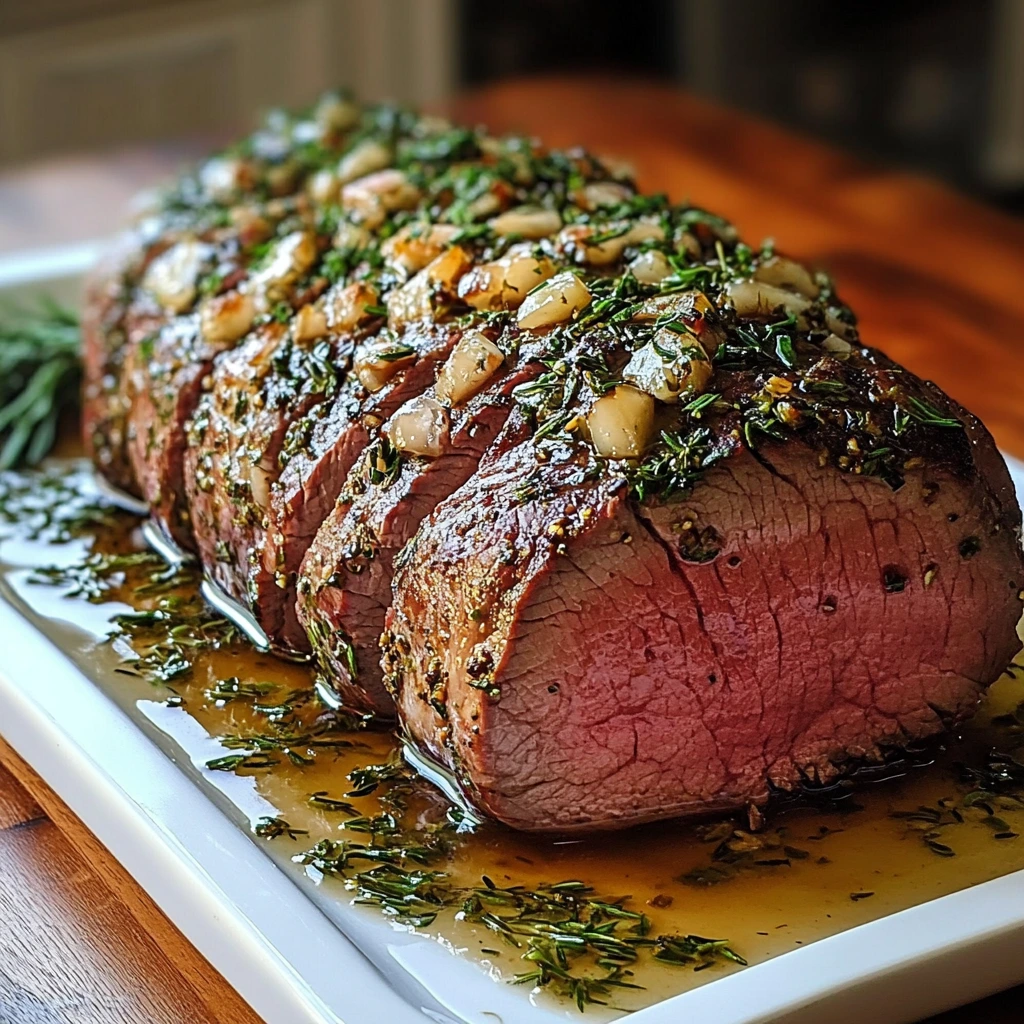
Preparing the Beef Tenderloin
Preparing your beef tenderloin correctly is a crucial step in ensuring it cooks evenly and retains its succulent texture. This process involves trimming, tying, and seasoning the meat with precision to enhance its natural flavors.
Step 1: Trimming the Beef Tenderloin
- Why it matters: Proper trimming removes the silver skin (a tough connective tissue) and excess fat, ensuring even cooking and better flavor absorption.
- How to trim:
- Use a sharp knife to carefully slice away the silver skin. Hold the blade at an angle to avoid cutting into the meat.
- Remove any large pieces of fat, leaving a thin layer for flavor.
- For a detailed guide, you can refer to this article on trimming beef.
Step 2: Tying the Tenderloin
- Why it matters: Tying the tenderloin helps maintain its cylindrical shape, which promotes uniform cooking.
- How to tie:
- Use butcher’s twine to secure the tenderloin at 1–2 inch intervals.
- Wrap the twine around the roast snugly but not too tight to allow for slight expansion during cooking.
- Pro tip: Focus on the thinner end of the tenderloin to avoid overcooking it during roasting.
Step 3: Bringing the Meat to Room Temperature
- Why it matters: Allowing the beef to come to room temperature (about 30–45 minutes) ensures even heat distribution, preventing overcooked edges and undercooked centers.
- Pro tip: Place the trimmed and tied tenderloin on a wire rack over a tray to allow airflow while it rests.
Step 4: Seasoning the Beef
- Why it matters: Proper seasoning highlights the tenderloin’s natural flavors and sets the foundation for a flavorful crust.
- Techniques for seasoning:
- Generously coat the meat with kosher salt and freshly cracked black pepper on all sides.
- Massage the seasoning into the meat for better adhesion and deeper flavor penetration.
- Pro tip: Season immediately before applying the herb butter to lock in moisture.
By meticulously trimming, tying, and seasoning your tenderloin, you’ll ensure it cooks evenly and retains its juicy, melt-in-your-mouth quality. These foundational steps are key to achieving a perfectly cooked Herb Butter Beef Tenderloin Roast.
Crafting the Herb Butter Mixture
The secret to a flavorful Herb Butter Beef Tenderloin Roast lies in the herb butter mixture. This aromatic blend of softened butter, fresh herbs, and garlic creates a rich, savory coating that enhances the natural flavors of the beef. Here’s how to make it perfectly.
Step-by-Step Guide to Herb Butter
- Soften the Butter
- Use unsalted butter and let it sit at room temperature for about 30 minutes. Softened butter blends more easily with herbs and garlic, ensuring a smooth mixture.
- Pro tip: Avoid melting the butter, as this can alter the texture of the mixture.
- Prepare the Herbs
- Chop fresh rosemary and thyme finely for an even distribution of flavor.
- Measure out 2 tablespoons each of rosemary and thyme. The fresh, earthy notes of these herbs are crucial for a robust herb butter.
- Mince the Garlic
- Use fresh garlic cloves for a bold and aromatic punch. Mince 4 cloves finely, or use a garlic press for convenience.
- Combine the Ingredients
- In a medium bowl, combine the softened butter, chopped herbs, and minced garlic.
- Mix thoroughly with a spatula or fork until all ingredients are evenly incorporated. The butter should have a smooth, spreadable consistency with visible flecks of herbs.
Tips for Perfect Herb Butter
- Use fresh herbs whenever possible for the most vibrant flavor. Dried herbs can be used in a pinch, but they’re less aromatic.
- To elevate the mixture, add a pinch of lemon zest for brightness or a dash of paprika for warmth.
- Make the herb butter in advance and refrigerate it. Bring it back to room temperature before use for easy spreading.
For additional tips on crafting flavorful butter mixtures, explore this guide to flavored butters.
By following these steps, you’ll create an herb butter that’s not only flavorful but also visually appealing, setting the stage for a memorable beef tenderloin roast.
Searing the Beef Tenderloin
Searing your beef tenderloin is a vital step that locks in flavor, enhances texture, and creates a beautifully caramelized crust. This process ensures your roast is both visually stunning and richly flavorful, making it the perfect centerpiece for any occasion.
Why Searing is Important
- Flavor: Searing triggers the Maillard reaction, which browns the meat’s surface and produces complex, savory flavors.
- Moisture retention: It forms a crust that helps seal in the tenderloin’s natural juices, ensuring a moist, succulent interior.
- Aesthetic appeal: A well-seared exterior adds a golden-brown color and an appetizing aroma to your roast.
Step-by-Step Guide to Searing
- Heat the Skillet
- Choose a large oven-safe skillet, such as cast iron, which retains heat evenly.
- Heat the skillet over medium-high heat for 2–3 minutes until it’s very hot.
- Add Oil
- Add 1 tablespoon of olive oil to the hot skillet. Swirl to coat the surface evenly.
- Ensure the oil is shimmering before placing the beef in the pan.
- Sear the Tenderloin
- Place the beef tenderloin in the skillet. Avoid crowding the pan to allow for even browning.
- Sear each side (top, bottom, and sides) for 3–4 minutes until a deep golden crust forms. Use tongs to handle the meat without piercing it.
- Prepare for Roasting
- Once all sides are seared, transfer the skillet directly to the preheated oven for roasting.
Safety Tips and Recommended Equipment
- Use high-heat oils like olive or avocado oil to prevent smoking.
- Handle the skillet with heat-resistant gloves to avoid burns when moving it from stovetop to oven.
- Ensure your kitchen is well-ventilated, as high-heat searing can produce smoke.
By mastering the art of searing, you’ll create a flavorful crust that perfectly complements the tender, juicy interior of your beef tenderloin roast.
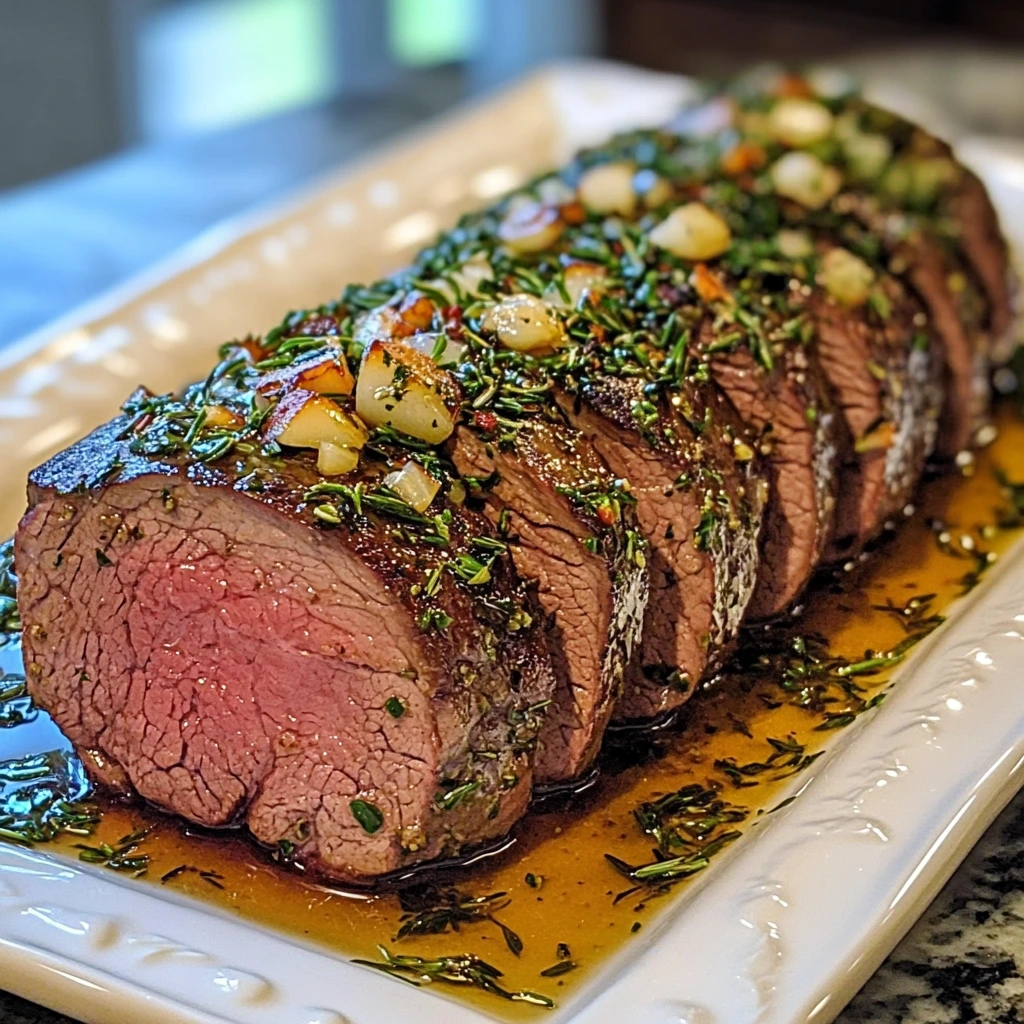
Roasting the Beef Tenderloin
Roasting the beef tenderloin is the final step in transforming this premium cut into a succulent, flavorful centerpiece. Proper roasting ensures the meat cooks evenly, retains its juices, and reaches the perfect level of doneness.
Step 1: Preheat the Oven
- Set the temperature: Preheat your oven to 425°F (220°C). This high heat allows the beef to roast quickly, locking in juices while achieving a beautiful crust.
- Why it matters: Consistent oven temperature is crucial for even cooking. Avoid opening the oven frequently, as it causes temperature fluctuations.
Step 2: Roasting Guidelines
Cooking times will vary based on the size of the tenderloin and your preferred doneness. Use this chart as a guide:
- Rare (120–125°F): Roast for approximately 20–22 minutes.
- Medium-Rare (130–135°F): Roast for 22–25 minutes.
- Medium (140–145°F): Roast for 25–30 minutes.
- Well-Done (150°F and above): Roast for 30+ minutes.
Pro tip: Begin checking the internal temperature 5 minutes before the recommended time to prevent overcooking.
For more insights on roasting times and techniques, refer to this comprehensive roasting guide.
Step 3: Using a Meat Thermometer
- Importance: A meat thermometer ensures your tenderloin is cooked to perfection without guesswork.
- How to use:
- Insert the thermometer into the thickest part of the roast, avoiding contact with the pan or any fat deposits.
- Check the temperature while the roast is still in the oven for the most accurate reading.
- Pro tip: Remove the tenderloin from the oven when the thermometer reads 5°F below your target temperature, as the meat will continue to cook during the resting period.
Key Tips for Perfect Roasting
- Use an oven-safe skillet to transfer the seared beef directly to the oven, minimizing dishwashing and retaining flavors.
- Let the roast rest for 10–15 minutes after removing it from the oven to allow the juices to redistribute.
By following these roasting techniques, you’ll achieve a perfectly cooked Herb Butter Beef Tenderloin Roast, ready to impress your guests with its melt-in-your-mouth texture.
Resting and Slicing the Roast
Once your Herb Butter Beef Tenderloin Roast is out of the oven, the process isn’t over just yet. Resting and slicing the roast correctly are crucial steps to preserve its juiciness and tenderness while ensuring a beautiful presentation.
Step 1: Importance of Resting the Meat
- Why it matters: Resting allows the meat’s juices to redistribute throughout the roast, preventing them from spilling out when sliced.
- How to rest:
- Cover the tenderloin loosely with aluminum foil to retain warmth without trapping steam.
- Let the roast rest for 10–15 minutes. This ensures every bite is as succulent and flavorful as possible.
Pro tip: If you slice too soon, the juices will escape, leaving the meat dry and less tender.
Step 2: Slicing the Beef Tenderloin
- Technique matters: Always slice against the grain. This shortens the muscle fibers, making the meat easier to chew and enhancing its tender texture.
- How to slice:
- Use a sharp carving knife for clean, precise cuts.
- Slice the roast into ½-inch thick slices for individual portions, or adjust thickness based on preference.
For more tips on carving techniques, check out this slicing guide.
Step 3: Presentation Tips
- Arrange the slices on a platter slightly overlapping for a restaurant-quality presentation.
- Garnish with a sprinkle of fresh parsley and a drizzle of herb butter for added color and flavor.
- Pair with roasted vegetables or mashed potatoes for a visually appealing and complete meal.
By allowing the roast to rest and slicing it properly, you’ll highlight the tenderloin’s juicy, melt-in-your-mouth qualities while presenting a dish that’s as stunning as it is delicious.
Serving Suggestions and Pairings
The beauty of a Herb Butter Beef Tenderloin Roast lies not only in its tender, flavorful meat but also in the accompaniments that elevate the meal into a culinary masterpiece. Here are the perfect side dishes, wine pairings, and garnishing tips to complement your roast.
Recommended Side Dishes
Pairing your tenderloin with thoughtfully chosen sides ensures a balanced and satisfying meal:
- Classic Mashed Potatoes: Creamy mashed potatoes provide a comforting contrast to the roast’s rich flavors.
- Roasted Vegetables: Carrots, asparagus, and Brussels sprouts, lightly seasoned and roasted, add earthy sweetness and color to the plate.
- Herb Butter Dinner Rolls: Serve warm rolls for guests to enjoy the extra herb butter from the roast.
Pro tip: Adding a tangy side, like a balsamic-glazed salad, cuts through the richness of the meat, balancing the flavors.
Wine Pairings
The right wine enhances the roast’s flavors and rounds out the dining experience:
- Red Wine: A full-bodied red like Cabernet Sauvignon or Merlot pairs beautifully with the roast’s rich, herbaceous notes.
- Alternative Option: For a lighter pairing, consider a Pinot Noir, which complements the tender beef without overpowering it.
Explore more about wine and food pairings in this guide.
Ideas for Garnishes and Plating
- Garnishes:
- Sprinkle fresh parsley over the sliced tenderloin for a vibrant, aromatic finish.
- Add a drizzle of melted herb butter for an extra layer of richness.
- Plating:
- Arrange tenderloin slices on a platter with roasted vegetables on the side.
- Use white serving dishes to highlight the roast’s golden crust and vibrant garnishes.
By pairing your tenderloin with complementary sides, wines, and garnishes, you’ll create a meal that not only impresses the palate but also elevates the overall dining experience.
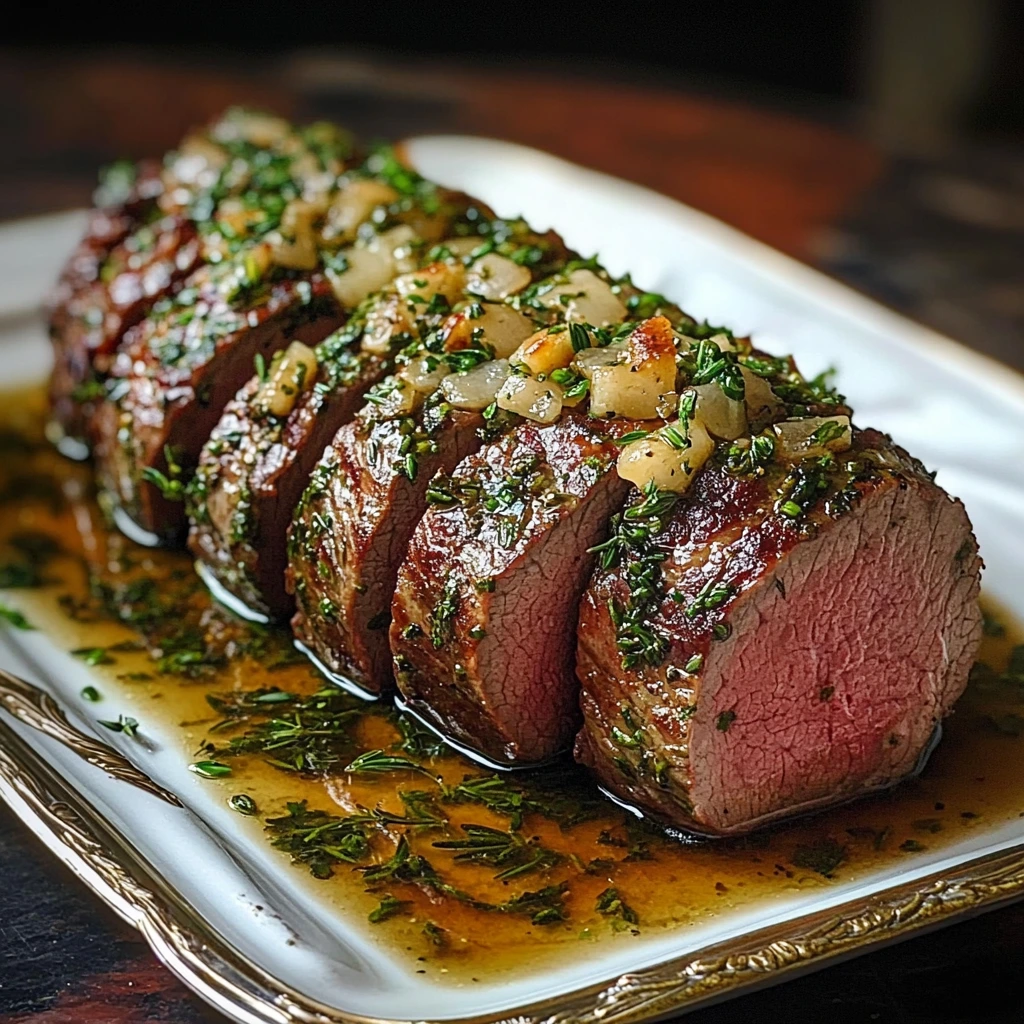
Frequently Asked Questions (FAQs)
Preparing and serving a Herb Butter Beef Tenderloin Roast can feel intimidating, but with the right tips, you’ll achieve success every time. Here are answers to the most common questions to help you master this dish.
1. How long should I let the beef tenderloin rest before slicing?
- Why it matters: Resting allows the juices to redistribute throughout the roast, ensuring a moist and flavorful result.
- Recommended time: Let the tenderloin rest for 10–15 minutes, covered loosely with foil. This step prevents the meat from losing its natural juices when sliced.
- Pro tip: Use a resting rack to keep the roast warm while allowing air circulation.
2. Can I prepare the herb butter in advance?
- Yes! Preparing the herb butter ahead of time saves time on the day of cooking.
- How to store: Mix the butter, herbs, and garlic as instructed, then wrap it in plastic wrap and refrigerate for up to 5 days or freeze for longer storage.
- Before use, let it come to room temperature for easier spreading. For detailed storage tips, check this guide on compound butter.
3. What is the best way to reheat leftovers without overcooking?
- Low and slow: To preserve tenderness, reheat sliced tenderloin in the oven at 275°F (135°C) for about 10–15 minutes, covered with foil.
- Alternative method: For smaller portions, use a skillet with a splash of beef broth over low heat. This prevents drying out while gently warming the meat.
- Avoid microwaving, as it can make the meat tough and unevenly heated.
4. How can I adjust the recipe for a larger or smaller tenderloin?
- Adjust cooking times: A larger tenderloin will require more roasting time, while a smaller one will cook faster. Use a meat thermometer to monitor internal temperature:
- Rare: 120–125°F
- Medium-rare: 130–135°F
- Medium: 140–145°F
- Always adjust the amount of herb butter proportionally to ensure even flavor coverage.
5. Is it necessary to tie the beef tenderloin before cooking?
- Yes, it’s highly recommended: Tying ensures the roast maintains a uniform shape for even cooking.
- How to tie: Use butcher’s twine to secure the tenderloin at 1–2-inch intervals, especially at the thinner end, which cooks faster.
- Pro tip: Tying also helps the roast hold its juices during cooking.
By following these answers and tips, you’ll confidently prepare a tender, flavorful Herb Butter Beef Tenderloin Roast that impresses every time.
Conclusion
Preparing the perfect Herb Butter Beef Tenderloin Roast is easier than it seems when you follow a few essential steps. From trimming and tying the tenderloin for even cooking to crafting a flavorful herb butter and mastering the art of searing, every step enhances the tenderloin’s succulent texture and rich taste. Roasting to the ideal internal temperature and allowing the meat to rest ensures the dish remains juicy and full of flavor.
This recipe is a fantastic choice for special occasions and holidays, offering a stunning main course that’s sure to impress your family and friends. The combination of tender beef, aromatic herbs, and golden crust creates a culinary experience that’s both memorable and delicious. Whether paired with classic sides like mashed potatoes and roasted vegetables or complemented by a robust red wine, this dish is the star of any table. For inspiration on sides and wine pairings, check out this helpful resource.
We invite you to try this recipe and make it your own. Experiment with additional herbs or unique side dishes to suit your taste. Share your experiences and any creative variations in the comments or with friends—it’s always exciting to see how others bring this dish to life in their kitchens!
PrintHerb Butter Beef Tenderloin Roast
A tender and flavorful beef tenderloin roast infused with garlic, rosemary, and thyme herb butter. Perfect for special occasions.
Ingredients
– 3 lb beef tenderloin roast
– ½ cup unsalted butter, softened
– 2 tbsp fresh rosemary, chopped
– 2 tbsp fresh thyme, chopped
– 4 garlic cloves, minced
– 1 tbsp olive oil
– Salt and pepper, to taste
– Fresh parsley, chopped (for garnish)
Instructions
1. Preheat oven to 425°F (220°C).
2. Pat tenderloin dry and season with salt and pepper.
3. Mix butter, rosemary, thyme, and garlic.
4. Coat beef with herb butter.
5. Sear all sides in a skillet with olive oil.
6. Roast for 20–25 mins (130°F for medium-rare).
7. Rest for 10–15 mins, slice, and garnish with parsley.
Notes
– Let the beef rest for perfect juiciness.
– Adjust roasting time for preferred doneness.
– Make herb butter ahead for convenience.

